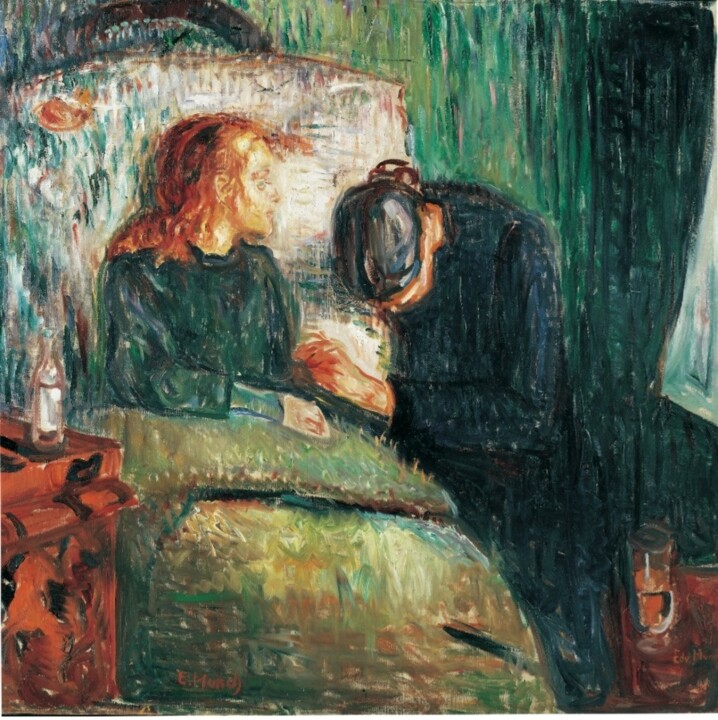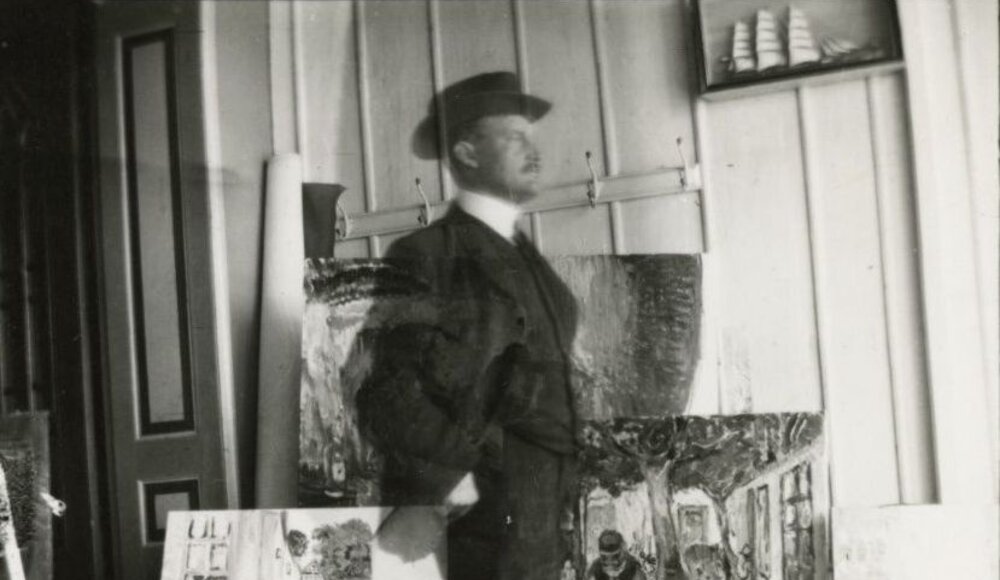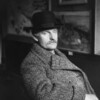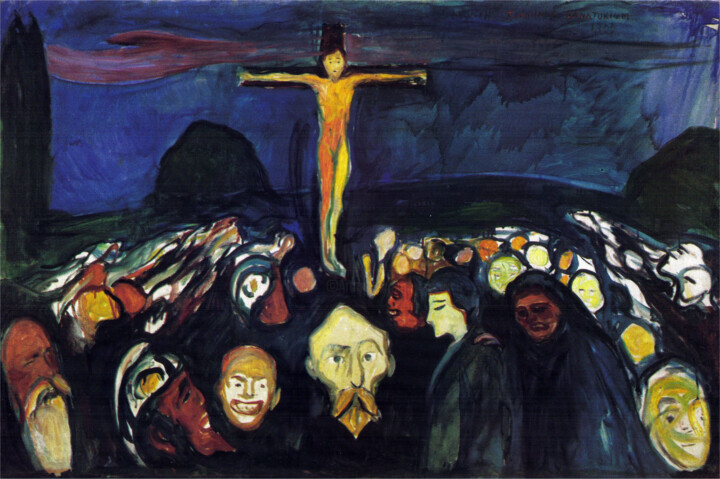 Edvard Munch - Self-Portrait at 53 Am Strom in Warnemünde, 1907. 8.9 × 8.9 cm. Munch Museum, Oslo, Norway
Edvard Munch - Self-Portrait at 53 Am Strom in Warnemünde, 1907. 8.9 × 8.9 cm. Munch Museum, Oslo, Norway
Who was Edvard Munch?
Edvard Munch created emotionally charged paintings that explored themes of love, death, and human vulnerability. He was influential in the development of Expressionism and Symbolism, and his paintings are known for their bold colors, simplified forms, and intense emotional and psychological content.
Munch's most famous work is "The Scream," which has become an iconic symbol of modern angst and anxiety. He also created many other notable paintings, including "Madonna," "The Dance of Life," and "Vampire." Munch's legacy has had a profound impact on the art world, inspiring generations of artists who followed in his footsteps.
 Edvard Munch - Puberty, 1894. Oil on canvas, 51.5 x 110 x 2.6 cm. National Museum of Art, Architecture and Design, Oslo, Norway
Edvard Munch - Puberty, 1894. Oil on canvas, 51.5 x 110 x 2.6 cm. National Museum of Art, Architecture and Design, Oslo, Norway
The Life of Edvard Munch
Edvard Munch was a Norwegian painter and printmaker who was born in 1863 in the town of Løten, Norway. He grew up in a family plagued by illness, poverty, and tragedy. When he was five, his mother died of tuberculosis, and his sister Sophie just nine years later of the same disease. These early experiences of loss and grief would have a profound impact on Munch's life and art.
As a young man, Munch studied art in Oslo and later in Paris, where he was exposed to the art of the Impressionists and Post-Impressionists. He began to develop his own unique style, characterized by bold colors, simplified forms, and emotionally charged subject matter.
 Edvard Munch - Self-Portrait, 1895. Lithograph, 45.8 x 31.4 cm. Munch Museum, Oslo, Norway
Edvard Munch - Self-Portrait, 1895. Lithograph, 45.8 x 31.4 cm. Munch Museum, Oslo, Norway
Munch's early works were met with controversy, but he continued to pursue his artistic vision, eventually gaining recognition and acclaim for his contributions to the art world. He was particularly influential in the development of Expressionism and Symbolism, and his paintings are known for their intense emotional and psychological content.
Throughout his life, Munch struggled with alcoholism, depression, and personal relationships, and his mental and physical health suffered as a result. He never married and had no children, and he often led a reclusive and solitary existence.
Munch continued to work and create art until his death in 1944 at the age of 80. Today, he is remembered as one of the most important and influential artists, and his art continues to be celebrated for its raw emotional power and haunting beauty.
Munch among the Impressionists
Edvard Munch was not officially part of the Impressionist movement, but he was heavily influenced by them and their approach to art. In particular, his time in Paris exposed him to the works of the Impressionists and Post-Impressionists, which had a significant impact on his own artistic vision.
In Paris, Munch studied at various academies and worked in the studios of other artists. He was particularly influenced by the works of Vincent van Gogh, whose use of color and expressive brushstrokes would later become Munch's hallmarks.
During his time in Paris, Munch also became involved in the bohemian art scene, socializing with other painters and writers. He developed close friendships with several French painters, including Paul Gauguin and Henri Toulouse-Lautrec.
 Edvard Munch - Evening Melancholy, 1891. Oil, wax crayon and pencil on canvas, 73 x 101 cm. Munch Museum, Oslo, Norway
Edvard Munch - Evening Melancholy, 1891. Oil, wax crayon and pencil on canvas, 73 x 101 cm. Munch Museum, Oslo, Norway
Nonetheless, there were significant areas in which Munch's art differed from the Impressionists. Compared to the more restrained manner of the Impressionists, his use of vivid colors and straightforward shapes was more expressive and emotive. He was also interested in exploring psychological states and emotions in his art, which set him apart from many of his contemporaries.
Despite these differences, Munch's exposure to the Impressionists was a key influence on his artistic development, and his work helped to bridge the gap between the Impressionist movement and the emerging modernist movement that followed.
Munch's experiences in Paris helped to shape his artistic vision, and he returned to Norway with a renewed sense of purpose and direction. He continued to develop his own unique style, characterized by bold colors and emotionally charged subject matter, and he became one of the most important and influential artists.
The Berlin Years
Edvard Munch spent a significant amount of time in Berlin during the early 20th century, and this time was a particularly productive and influential time in his career. He first visited the city in 1892, when he exhibited at the Verein Berliner Künstler (Association of Berlin Artists), and he returned frequently over the next several decades.
Munch continued to develop his own unique style during his time in Berlin, which was characterized by bold colors, simplified forms, and emotionally charged subject matter. His paintings from this period include powerful images of human emotion, such as "The Sick Child" and "Self-Portrait with a Bottle of Wine".
 Edvard Munch - The sick child, 1907. Oil on canvas, 118.7 x 121 cm. Tate Modern, London.
Edvard Munch - The sick child, 1907. Oil on canvas, 118.7 x 121 cm. Tate Modern, London.
During his time in Berlin, Munch became involved in the city's vibrant art scene, which was characterized by a growing interest in modernism and expressionism. He became associated with the German Expressionist movement and exhibited in some of the city's most prominent galleries and museums. He developed close friendships with several German painters, including Ernst Ludwig Kirchner and Emil Nolde, who were also associated with the Expressionist movement.
Overall, Munch's time in Berlin was a significant period in his career, and his influence on the German art scene helped to shape the development of modernism and expressionism in the early 20th century.
Late years
In his later years, Edvard Munch continued to work as an artist, but his health began to decline. He suffered from alcoholism, which exacerbated his existing physical and mental health issues.
Despite his declining health, Munch continued to explore new techniques and styles, experimenting with lithography and woodcuts in addition to painting.
 Edvard Munch - Kiss IV, 1902. Woodcut print, 47 × 77 cm. Munch Museum, Oslo, Norway
Edvard Munch - Kiss IV, 1902. Woodcut print, 47 × 77 cm. Munch Museum, Oslo, Norway
In 1937, Munch's work was featured in a major retrospective exhibition in Oslo, which brought him renewed recognition and acclaim. However, his health continued to deteriorate, and he spent much of his time in seclusion.
Munch died in his home in Oslo in 1944 at the age of 80. His art continues to be celebrated for its raw emotional power and its influence on the art world. Today, his legacy lives on in the many museums and galleries that house his art, as well as in the ongoing impact of his artistic vision.
Legacy
The legacy of Edvard Munch is one of profound influence on the art world, particularly in the realms of Expressionism and Symbolism. His emotionally charged and psychologically complex works have left an indelible mark on modern art, inspiring generations of artists who followed in his footsteps.
Munch's most well-known piece, "The Scream," which has been often reproduced and referred to in popular culture, has come to represent modern angst and fear. His use of bold colors and expressive brushwork, combined with his deeply personal themes, have had a lasting impact on the art world.
In addition to his contributions to art, Munch was also a significant figure in the development of the modern art market. He was one of the first artists to actively participate in the marketing and sale of his own work, which paved the way for future generations to take control of their own careers.
Edvard Munch's works can be found in many museums around the world. Some of the most notable collections include:
Munch Museum, Oslo: This museum holds the largest Munch's collection, with over 28,000 pieces in its collection, including paintings, drawings, and prints. The museum also houses a significant collection of Munch's personal belongings and archives.
National Gallery, Oslo: The National Gallery has a significant Munch's collection, including several versions of "The Scream." It also has an extensive collection of Norwegian art from the 19th and 20th centuries.
The Metropolitan Museum of Art, New York: The Met has a collection of over a dozen Munch works, including several versions of "The Scream" and "Madonna." The museum also has an extensive collection of European art.
The Museum of Modern Art, New York: MoMA has a collection of several Munch works, including "The Scream". The museum is known for its extensive collection of contemporary art.
The British Museum, London: The British Museum has a collection of Munch prints, including several woodcuts and lithographs. The museum is known for its extensive collection of art and artifacts from around the world.
These are just a few examples of the many museums around the world that house Edvard Munch’s art, and his influence on the art world continues to be felt to this day.
Important art by Edvard Munch
Edvard Munch made many notable art throughout his career, but some of his most famous and influential paintings include:
"The Scream" (1893) is one of the most famous works of art in the world. It depicts a figure on a bridge, with their head thrown back and mouth open in a silent scream. The figure is surrounded by a surreal, swirling sky in shades of red, orange, and yellow.
The painting is highly symbolic and has been interpreted in many different ways. Some see the figure as a representation of the artist himself, expressing his own anxiety and despair. Others believe it to be a symbol of modern society's general concern.
"The Scream" is known for its use of vivid colors, bold lines, and distorted shapes. Munch made several versions of the painting, including two oil paintings and several prints. The most famous version is the oil painting that is part of the collection at the National Gallery in Oslo, Norway.
"The Scream" has become an iconic image in popular culture, appearing in films, television shows, and advertising. It is also highly valued by art collectors and is considered one of the most important works of art of the 20th century.
 Edvard Munch - The Scream, 1893. Tempera and wax crayon on board, 91 x 73.5 cm. National Museum of Art, Architecture and Design, Oslo, Norway.
Edvard Munch - The Scream, 1893. Tempera and wax crayon on board, 91 x 73.5 cm. National Museum of Art, Architecture and Design, Oslo, Norway.
"Madonna" (1894) is one of Edvard Munch's most famous paintings. It depicts a nude woman with long hair, sitting on a bed with her arms raised above her head. The woman's face is not visible, as it is obscured by her hair.
The painting is highly symbolic, with many interpretations of its meaning. Some see the figure as a representation of the Virgin Mary, while others see her as a symbol of sexuality and fertility. The woman's raised arms have been interpreted as a sign of surrender or of transcendence.
Munch's use of vibrant colors and bold lines give the painting a sense of emotional intensity. The bright red and orange hues of the bed contrast with the pale skin of the woman, creating a dynamic composition.
It is one of several works by Munch that explore themes of love, desire, and spirituality. The painting has become an iconic image in the world of art, and has been reproduced in countless prints and posters. The original painting is currently part of the collection at the Munch Museum in Oslo, Norway.
 Edvard Munch - Madonna, 1894. Oil on canvas, 90 x 68 cm. Munch Museum, Oslo, Norway.
Edvard Munch - Madonna, 1894. Oil on canvas, 90 x 68 cm. Munch Museum, Oslo, Norway.
"The Dance of Life" (1899-1900) depicts three figures, a man and two women, in different stages of life, dancing together in a surreal, dream-like landscape. The painting is rich in symbolism and has been interpreted in many different ways. Some see it as a representation of the stages of life, with the young couple representing youth, the middle-aged couple representing maturity, and the old man representing death. Others see it as a commentary on the fleeting nature of happiness and the inevitability of mortality.
"The Dance of Life" is considered one of Munch's masterpieces and is part of the collection at the Munch Museum in Oslo, Norway.
 Edvard Munch - The dance of life, 1899-1900. Oil on canvas, 125 x 191 cm. National Museum of Art, Architecture and Design, Oslo, Norway
Edvard Munch - The dance of life, 1899-1900. Oil on canvas, 125 x 191 cm. National Museum of Art, Architecture and Design, Oslo, Norway
"Love and Pain (Vampire)" is a haunting and iconic work of art. It depicts a man and a woman locked in a passionate embrace, with the woman's head tilted back and her hair cascading down her back. The man's face is partially obscured, and his hands seem to be pulling the woman closer to him.
Between 1893 and 1895, Munch created six variations of the same theme. The Munch Museum in Oslo has three copies, the Gothenburg Museum of Art has one, a private collector has another, and the final version is unidentified.
The work is highly symbolic and has been interpreted in many different ways. Some see the figures as representations of the destructive power of love, with the woman as the seductive vampire who feeds on the man's life force. Others see it as a commentary on the dangerous and seductive power of art itself.
 Edvard Munch - Love and Pain (Vampire), 1895. Oil on canvas, 91 x 109 cm. Munch Museum, Oslo, Norway
Edvard Munch - Love and Pain (Vampire), 1895. Oil on canvas, 91 x 109 cm. Munch Museum, Oslo, Norway
Haunting and powerful "Puberty" (1894) is a deeply symbolic, exploring themes of sexuality, vulnerability, and power. Some see it as a representation of the confusion that often accompanies the transition from childhood to adolescence. Others see it as a commentary on the ways in which societal expectations and norms can shape and restrict our understanding of ourselves and our bodies.
Munch's use of color and line is particularly effective in "Puberty", with the bright, almost garish colors of the girl's skin and hair contrasting sharply with the muted tones of the background. The girl's posture, with her head bowed and her hands clasped, gives her a sense of vulnerability and powerlessness.
"Puberty" is considered a masterpiece of symbolism and expressionism, and it is part of the collection at the Munch Museum in Oslo, Norway.
These paintings, along with many others, demonstrate Munch's unique artistic vision and his ability to capture powerful emotional and psychological states in his art.


 Selena Mattei
Selena Mattei





